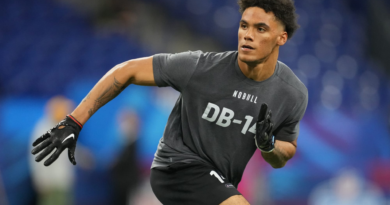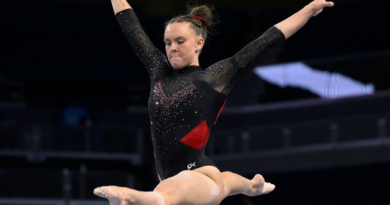What went wrong for the Rangers in Game 1 — and what can they fix for Game 2?
For the first time in the 2024 Stanley Cup playoffs, the New York Rangers trail in a series. The Florida Panthers skated out of Madison Square Garden on Wednesday night with a convincing, at times dominating, 3-0 victory in Game 1 of the Eastern Conference finals.
But Rangers coach Peter Laviolette’s confidence in his Presidents’ Trophy-winning team hasn’t wavered.
“Can we win [Game 2]? I definitely believe we can win,” he said Thursday.
Laviolette said Game 1 was “an even game” between the teams: close on the scoreboard and in the analytics. Breaking down what went wrong for the Rangers against Florida to open the conference final — and how to fix those problems — shows his confidence isn’t outlandish.
Here are five things the Rangers could seek to change for Game 2 on Friday night (8 p.m. ET, ESPN/ESPN+):

“Take responsibility” with execution
From 16:26 of the first period until 16:12 of the third period, the Panthers led Game 1 by a single goal. It was a tenuous lead that was threatened in multiple ways by the Rangers.
“We had a lot of chances to score. We hit the post three times. A lot of point-blank chances. Two breakaways,” Laviolette said. “There’s opportunities where we could have scored that one goal and it didn’t go.”
One Rangers goal in that time span obviously changes everything. It energizes the crowd. It allows New York to relax a bit. It might even mean a trip to overtime, where the Rangers won twice last round. Comeback wins are what this team does: The Rangers have 33 come-from-behind wins between the regular season and the playoffs, tied with the 2006 Hurricanes and 1984 Oilers for the most in NHL history.
But they didn’t get that bounce. They did get some chances, and Laviolette said his team has to “take responsibility with our execution” in Game 2.
When Laviolette discusses Game 1, he does so without a hint of panic, despite his team trailing in a series for the first time this postseason. Even as the numbers show the Panthers got the better of play at 5-on-5, the Rangers coach didn’t see his team getting dominated at even strength.
“I don’t feel like we were under siege. I don’t feel like we were real vulnerable at times defensively,” he said.
Laviolette isn’t averse to making changes to his team’s approach if necessary. He just doesn’t see that necessity yet.
“There were adjustments that we made in the Carolina series, systematically, because I didn’t like what I was seeing. I didn’t like how it was coming at us. So we changed big parts of our game to try and make up for that,” he said. “But I didn’t feel like it was that [in Game 1].”
Pressure on the D corps
If there’s one group on the Rangers that needs to step up, it’s the defensemen — on both ends of the ice.
New York doesn’t have a player in the top 20 for playoff scoring or shots on goal by a defenseman. Its blue line has generated just two goals. Adam Fox and Jacob Trouba are tied for the team lead for D-men with four points. The Panthers’ leaders — Gustav Forsling and Brandon Montour — have double that output. No one’s even in the same conversation as Evan Bouchard and Miro Heiskanen in the Western Conference finals as far as offensive output.
The Rangers struggled to generate shots on goal in Game 1, going 14:25 between shots in the second period. Getting more from the D corps would certainly help.
Laviolette said there are opportunities for the Rangers’ defensemen to get more involved offensively after being “a big part of our success in the regular season.”
Fox agreed with his coach.
“We want to produce. Getting up in the rush, joining late … we want to jump in when the opportunity presents itself,” he said.
But New York needs its defensemen to be sharper in their own zone, too. Specifically, finding more success in breaking out the puck so the big, physical Panthers can’t get their forecheck cranked up like they did in Game 1.
“They have a lot of speed on their team,” K’Andre Miller said. “I think limiting their speed throughout the neutral zone, trying to get hold-ups and trying to give us a little bit more time breaking the puck out of the D zone [are key].”
“Obviously, when teams are coming that hard and pressuring you with that type of energy, I think [it’s about] breaking down their forecheck with talking, puck moving and just trying to be a little bit firmer,” he added. “Our execution can be a little bit better coming out of the D zone.”
The Panarin line must produce
The trio of Vincent Trocheck, Artemi Panarin and Alexis Lafreniere were on the ice for a goal in Game 1. Unfortunately it was one for the Panthers, as a turnover by Rangers goalie Igor Shesterkin led to a puck going off Lafrenière’s stick into New York’s net in the third period.
(Panarin and Lafrenière were also on the ice for Matthew Tkachuk‘s game-opening goal.)
Their line didn’t score, but it wasn’t for a lack of trying. Yet again, the Panarin line was New York’s best at 5-on-5 with a plus-6 in shot attempts and a plus-4 in scoring chances. It was the only Rangers line with its head above water in shot attempts; the Chris Kreider–Mika Zibanejad–Jack Roslovic trio was the only other line in the positive on scoring chances, and it was only a plus-1.
The Rangers’ challenges at 5-on-5 have been well documented. The Panarin line has been the exception all season and all postseason: Plus-38 in shot attempts, plus-19 in scoring chances and plus-6 in high-danger chances in the playoffs. Yet that’s added up to seven goals for and seven goals against in 11 games.
In Game 1, it was Zibanejad who saw Selke Trophy-winning center Aleksander Barkov the most. Trocheck played the majority of his minutes against Anton Lundell. While that’s not an easy matchup, it’s an easier matchup than the Barkov line. The Rangers need their best trio to take advantage of that in Game 2.
Panthers goalie Sergei Bobrovsky pitched a 24-save shutout in Game 1, the second playoff blanking of his career. He was good when Florida needed him to be, including three high-danger saves and seven stops on rebound attempts. But the Rangers didn’t get nearly enough traffic in front of him, and they know it.
“Making it harder on Bobrovsky [is critical],” forward Barclay Goodrow said. “Obviously, he’s a good goalie. If he sees pucks, life is easy. He’s going to make most of those saves, so just making life more difficult on him.”
“Playoff Bob” has faced more high-danger shots against (66) and has the highest high-danger save percentage (.879) in the playoffs. It’s the midrange stuff that has tripped him up — seven goals on 43 shots at even strength. For goalies with at least eight appearances in the 2024 playoffs, Bobrovsky is seventh of eight netminders in save percentage on shots through traffic (.902). The Rangers need to create more of it.
As the Rangers were struggling to generate excitement in front of a quiet crowd in Game 1, ESPN analyst Mark Messier wondered if “maybe they should think about putting Rempe in the lineup” to spark the team.
The sentiment has been echoed by fans and pundits since Game 1: Should it be Rempe Time in Game 2?
The 6-foot-8 rookie is an automatic crowd pop when he steps on the ice, and those cheers grow louder when he pops an opponent with a big check. The Panthers were the more physical team in Game 1. Perhaps Rempe could respond to that.
Of course, responding is the issue. The Panthers have shown a remarkable discipline in this postseason on not getting goaded into after-the-whistle shenanigans. And Rempe is clearly on the referees’ radar, having gotten his share of reputation penalties this season.
Getting Rempe in the lineup at home would seem essential. But is it worth dedicating a forward spot to a player who averages 6:19 of ice time per game in the playoffs just for an energy boost?
If not Rempe, the Rangers could play another card that could energize the crowd and the team. Blake Wheeler, 37, hasn’t played since Feb. 15 after a gruesome leg injury. He has worked hard to get back in the lineup, and told ESPN that he’s “an option and available” for the Eastern Conference finals if Laviolette needs him.
Whether it’s the lineup or the execution, something has to change for the Rangers in Game 2 if they want to change their results against the Panthers.




